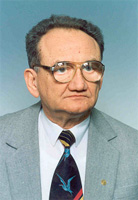 |
The "Sabba
S. Stefanescu"
Institute of Geodynamics of the Romanian Academy (IG"SSS"AR)
- director Prof. Dorel Zugravescu,
member of the Romanian Academy was constituted in 1990,
simultaneously with the revival of the Romanian Academy, which
became possible after the destructuring of the whole consisting of
the Soviet Union and the countries in its orbit.
The Institute continues a tradition begun in the
framework of the Geophysical Research Centre of the Romanian
Academy when, on the occasion of the February 15, 1961, total
solar eclipse, it may be considered that experimental Geodynamcis
was introduced in our country. |
On the occasion of this eclipse, in a building
belonging to the Caldarusani monastic complex (Fig.2) the first recordings
of the variations in time of the gravitational field in our country were
carried out, using as a sensor an Askania type gravimeter and recording
systems of own construction. On the same occasion, recordings were carried
out with a paraconical pendulum, also of own construction, made after the
photos and details put at our disposal by Prof. Maurice Allais (Nobel
Prize for Economy in 1988) who performed, with the pendulum he had built,
similar determinations, on the occasion of the solar eclipses in 1954 and
1958.
We
underline the fact that at present, the Caldarusani Geodynamics
Observatory is functioning in the building where these recordings were
carried out and that the co-operation established in 1961 between the Caldarusani Monastery -
the Romanian Orthodox Church
and the Caldarusani
Geodynamics Observatory (the Geophysical Research Centre) - the Romanian
Academy, was officially celebrated in 2001 (Fig.3), at the
anniversary of four decades of existence of the first and up to now the
only co-operation established between one of the orthodox churches - the Romanian
Orthodox Church - and science - the Romanian
Academy.
In time, after the dissolution of the Geophysical
Research Centre of the Romanian Academy in 1970, the various
administrative reorganizations which affected the research structure of
our country led to the functioning of the Caldarusani
Geodynamics Observatory as a research laboratory, first as part of the
Bucharest Astronomic Observatory
and then, for a short time, as part of the Institute
of Geology and Geophysics of the Ministry of Mines, Petroleum and Geology.
Subsequently, till the constitution, on its structure, of the "Sabba
S. Stefanescu" Institute of Geodynamics of the Romanian Academy,
the Laboratory of Geodynamics functioned in the framework of the Centre
of Earth Physics and Seismology, together with a laboratory of
seismology, which became in 1990 the National Institute for Earth Physics,
a laboratory of rock mechanics and a research group for natural fields.
The Laboratory of Geodynamics and the research group
for natural fields constituted the basic nucleus of the Institute of
Geodynamics. This nucleus created, gradually, a material basis consisting,
in the beginning, almost exclusively of specific geodynamics equipment,
conceived and built in the framework of its own laboratories, sometimes
also in co-operation with specialists belonging to other research groups
from our country (institutes of the Romanian Academy, the Department of
Geophysics of the University of Bucharest,
research units from Physics Platform Bucharest-Magurele) and from abroad
(the Royal Observatory of Belgium, l'Institut de Physique du Globe Paris -
France, the Geodynamics Department of the Institute of Theoretical
Geodesy, Bonn University - Germany, the Nagoya University - Japan).
An essential role for the evolution of research in
geodynamics in our country has been played by the collaboration, doubled
by unfailing friendship relations, established already since the sixth
decade of the last century, with Prof. Manfred Bonatz, head of the
Laboratory for Geodynamics in the Institute for Theoretical Geodesy of the
University of Bonn, and Prof. Paul Melchior, at the time the Director of
the Royal Belgian Observatory, today a baron ennobled by King Baudouin for
his scientific merits.
These links have been strengthened in 1993 by a
multilateral collaboration signed by representatives of the elite of
European geodynamics (Prof. Paul Paquet, Prof. Bernard Ducarme, from the
part of the Royal Belgian Observatory -
Belgium, Prof. Manfred Bonatz, from the part of the Institute for
Theoretical Geodesy of the University of Bonn - Germany, Eng. Jan Flick,
from the part of the Walferdange Observatory - Grand-duchť de Luxemburg,
Prof. Dorel Zugravescu, from the part of the "Sabba S.
Stefanescu" Institute of Geodynamics of the Romanian Academy -
Romania, prof. Jean Louis LeMouŽl, Membre de l'Institut, from the part of
the Institute of Earth Physics Paris - France), a collaboration financed
by the European Community, which made possible:
-
a
better knowledge about the space-time evolution of certain parameters
causally linked with the accumulation and the release of energy
related to earthquakes in the zone of Vrancea, Romania;
-
an
extension and a development of the material basis dedicated to the
study of the active geodynamic zone of Vrancea;
-
the
organization, in June-July 2000, of an European Mission of Geodynamics
(Fig.4).
|



